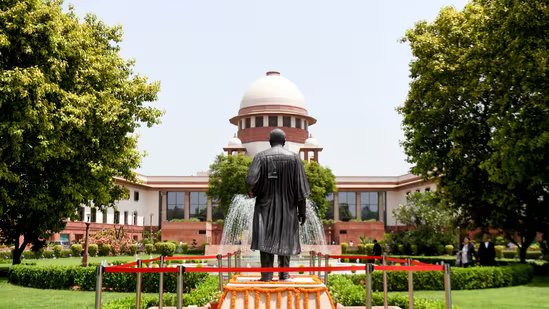Supreme Court Issues Notice to ‘X’ and Assam BJP Over Controversial AI-Generated Video
In a significant legal development, the Supreme Court of India has issued notices to the social media platform ‘X’ (formerly Twitter) and the Assam unit of the Bharatiya Janata Party (BJP) regarding a contentious video that has sparked concerns over communal harmony. The video, which is AI-generated, suggests a “Muslim takeover” of Assam if the BJP fails to secure victory in the upcoming assembly elections. This case raises critical questions about the intersection of technology, politics, and communal relations in India.
Background of the Controversy
The video in question was posted on September 15 by the BJP’s Assam unit and has since garnered significant attention, amassing over 4.6 million views, 19,000 likes, and being reposted 6,100 times by September 18. The content features individuals depicted as Muslims, wearing skullcaps and beards, taking control of various iconic Assam landmarks, including tea estates and the Guwahati airport. Such imagery has been interpreted as a direct attempt to incite fear and communal discord among the electorate.
Advocate Nizam Pasha, representing the applicant who filed the plea, argued that the video is not merely a political advertisement but a dangerous narrative that vilifies a specific community. He emphasized that the portrayal of Muslims as a threat to the state undermines the secular fabric of the Indian Constitution, which mandates equal treatment for all citizens regardless of their religion.
Legal Implications and Constitutional Concerns
The application filed in the Supreme Court highlights the constitutional obligations of the ruling party. It asserts that the BJP, as a governing body, is bound to uphold the secular values enshrined in the Constitution. The plea states, “The ruling dispensation, BJP-Assam, is bound by the Constitution of India and thereby is bound to uphold the secular values that form part of the basic structure of the Constitution.” This assertion underscores the expectation that elected officials should act as guardians of all communities, promoting unity rather than division.
The plea further argues that the video represents a “gross failure” and a “complete disregard” for these secular values. It calls for immediate action to prevent further communal disharmony, urging the court to initiate penal measures against those responsible for the video’s content. The legal framework surrounding hate speech in India is complex, with various laws prohibiting communal incitement. The Supreme Court’s involvement in this case could set a precedent for how such issues are handled in the digital age.
The Role of Social Media in Political Discourse
The rise of social media has transformed political communication, allowing for rapid dissemination of information and ideas. However, it has also facilitated the spread of misinformation and hate speech. The case against the BJP’s Assam unit raises important questions about the responsibilities of social media platforms in moderating content. The applicant’s plea specifically calls for ‘X’ to take down the video to mitigate the risk of communal unrest.
This incident is not isolated; it reflects a broader trend in which political parties leverage social media to influence public opinion. The use of AI-generated content adds another layer of complexity, as it blurs the lines between reality and fabrication. The implications of such technology in political campaigning are profound, raising ethical concerns about authenticity and accountability.
Historical Context of Communal Tensions in Assam
Assam has a long history of communal tensions, often exacerbated by political narratives that exploit religious identities. The state has witnessed violent clashes between different communities, particularly between indigenous populations and migrant groups. The BJP has positioned itself as a protector of Assamese identity, often framing its political discourse around the idea of safeguarding the state from perceived threats.
The portrayal of Muslims in the recent video taps into historical fears and anxieties, potentially inflaming existing tensions. This strategy of using fear as a political tool is not new; it has been employed by various parties throughout India’s democratic history. However, the advent of social media has amplified its reach and impact, making it crucial for the judiciary to intervene when such narratives threaten communal harmony.
The Supreme Court’s Role in Upholding Secularism
The Supreme Court’s decision to issue notices to both ‘X’ and the Assam BJP unit reflects its commitment to upholding the principles of secularism and communal harmony. The court has historically played a pivotal role in adjudicating matters related to hate speech and communal violence. By taking up this case, the judiciary signals its recognition of the potential dangers posed by divisive political rhetoric, especially in an increasingly polarized society.
The court’s actions could lead to a broader examination of how political parties utilize social media to shape narratives and influence electoral outcomes. It may also prompt discussions about the need for stricter regulations governing online content, particularly in the context of hate speech and communal incitement.
Conclusion
The Supreme Court’s notice to ‘X’ and the Assam BJP unit over the controversial AI-generated video underscores the delicate balance between political expression and communal harmony in India. As the country approaches the assembly elections, the implications of this case extend beyond legal ramifications; they touch upon the very fabric of Indian democracy. The judiciary’s intervention may serve as a crucial step in safeguarding secular values and promoting a more inclusive political discourse. As the situation unfolds, it will be essential to monitor how this case influences both public sentiment and the broader political landscape in Assam and beyond.











